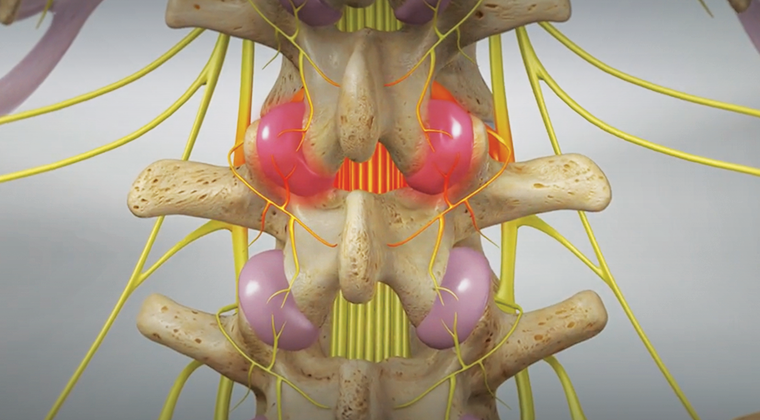Lumbar Sympathetic Nerve Block
What is the purpose of this procedure?
The lumbar sympathetic nerve block is a procedure used to decrease pain in the lower limbs. The lumbar sympathetic nerves are located on either side of the lumbar spine (lower back). After an injury or illness, the nervous system may not function properly and cause persistent pain. Some of the more common conditions treated with this injection include: Complex Regional Pain Syndrome (CRPS) (also known as Reflex Sympathetic Dystrophy), Sympathetic Maintained Pain, and Herpes Zoster (shingles). If the block relieves your pain, the doctor will then perform a series of blocks at another time in an attempt to break the pain cycle and provide long-lasting pain relief. The number of blocks you may need depends on how long the pain relief lasts between injections. Usually you will get more pain relief with each subsequent injection.
What are the risks associated with this procedure?
The risks are infrequent. They include:
• Allergic reaction to the medication
• Nerve damage
• Damage to surrounding structures
• Bleeding and bruising at the injection site
• Infection
• Injection of medication into a blood vessel
• No improvement or worsening of pain in some cases
How should I prepare for the procedure?
• You must have a driver with you at the time of check-in and check-out. Your driver must accompany you to the clinic for your procedure. You can be discharged only to the care of a responsible adult driver 18 years of age or older.
• Since you may receive sedation, it is important that you do not eat within 6 hours before the procedure. Small amounts of clear liquids are ok up to 2 hours before the procedure. If you are a diabetic, be sure to discuss an eating and medication schedule with your doctor.
• You may need to stop taking certain medications several days before the procedure. Please remind the doctor of all prescription and over-the-counter medications you take, including herbal and vitamin supplements. The doctor will tell you if and when you need to discontinue the medications.
• It is very important to tell the doctor if you have asthma or had an allergic reaction to the injected dye for a previous radiology exam (CT scan, angiogram, etc.). An allergic reaction has symptoms such as hives, itchiness, difficulty breathing, or any treatment which required hospital stay. The doctor may prescribe medications for you to take before having the procedure.
• Tell the doctor if you develop a cold, fever, or flu symptoms before your scheduled appointment, or if you have started taking antibiotics for an infection.
What will happen during the procedure?
The lumbar sympathetic nerve block is an outpatient procedure usually done in a special procedure room.
- For fluids and sedation, the nurse or doctor places an IV line and temperature monitors on your feet or lower leg.
- For your safety and comfort, you will be connected to monitoring equipment (EKG monitor, blood pressure cuff, and blood oxygen monitoring device), and positioned on your stomach.
- Your back is cleansed with an antiseptic soap and the doctor injects numbing medicine into your skin and tissue. This will cause a burning sensation for a few seconds.
- After the numbing medicine takes effect, the doctor inserts another needle and (with the assistance of a special x-ray machine called a fluoroscope) injects contrast dye (radiopaque dye) to help see the location better and ensure the needle is in proper position. With the needle in position, the pain relief medication (anesthetic) is injected.
- Following the procedure, the temperature in your feet will be monitored to make sure the block was successful. For your safety you will remain in recovery until the provider feels you are medically ready to leave.
What should I expect after the procedure?
• You may experience some weakness or numbness in your legs a few hours after the procedure. If so, do not engage in any activities that require heavy lifting, balance or coordination.
• Do not drive for the remainder of the day.
• You may resume usual activities and return to work the following day.
• If the doctor prescribes physical therapy, it is very important that you continue with the physical therapy program.
Content supplied by:
Ronald Wasserman, M.D.
1.29.2020
Disclaimer: This document contains information and/or instructional materials developed by Michigan Medicine for the typical patient with your condition. It may include links to online content that was not created by Michigan Medicine and for which Michigan Medicine does not assume responsibility. It does not replace medical advice from your healthcare provider because your experience may differ from that of the typical patient. Talk to your healthcare provider if you have any questions about this document, your condition or your treatment plan. Patient Education by Michigan Medicine is licensed under a Creative Commons Attribution-NonCommercial-ShareAlike 3.0 Unported (CC BY-NC-SA 3.0) License. Last Revised 06/2018.



